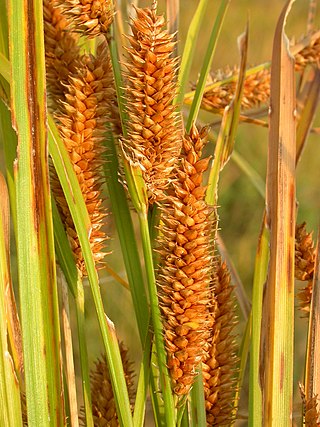
Equisetum telmateia, the great horsetail, is a species of Equisetum (horsetail) native to Europe, western Asia and northwest Africa. It was formerly widely treated in a broader sense including a subspecies in western North America, but this is now treated as a separate species, Equisetum braunii.

Carex echinata is a species of sedge known by the common names star sedge and little prickly sedge.

Carex nebrascensis is a species of sedge commonly known as Nebraska sedge.

Carex utriculata is a species of sedge known as Northwest Territory sedge,common beaked sedge or common yellow lake sedge.

Carex vesicaria is an essentially Holarctic species of sedge known as bladder sedge, inflated sedge, and blister sedge. It has been used to insulate footwear in Norway, Sweden and among the Sami people, and for basketry in North America.

Carex binervis, the green-ribbed sedge, is a European species of sedge with an Atlantic distribution. It is found from Fennoscandia to the Iberian Peninsula, and occurs in heaths, moorland and other damp, acidic environments. It typically grows to a height of 15–120 cm (6–50 in), and has inflorescences comprising one male and several female spikes, each up to 45 mm (1.8 in) long. The utricles have two conspicuous green veins, which give rise to both the scientific name and the common name of the species. In the vegetative state, it closely resembles C. bigelowii, a species that usually grows at higher altitude. C. binervis was first described by James Edward Smith in 1800, and is classified in Carex sect. Spirostachyae; several hybrids with other Carex species are known.

Carex unilateralis, the lateral sedge, is a species of sedge that was first described by Kenneth Mackenzie in 1922. The specific epithet, unilateralis, is derived from Latin and means "one-sided".

Cyperus longus is a species of sedge known by the common names of sweet cyperus and water rush in Africa, or in Britain galingale.

Carex fascicularis, commonly known as tassel sedge, is a species of sedge of the family Cyperaceae that is native to Australia, New Zealand and New Guinea.

Carex inversa, commonly known as knob sedge, is a species of sedge of the family Cyperaceae that is native to parts of Australia and New Zealand and has also been introduced into Great Britain.

Carex viridula, known as little green sedge, green sedge, or greenish sedge, is a small flowering plant native to North America, Europe, Asia, and Morocco.

Carex elata, is a species of tussock-forming, grass-like plant in the Cyperaceae family. It is native to all of Europe, the Atlas Mountains of Africa, Turkey, Iran and Central Asia.

Carex remota, the remote sedge, is a species in the genus Carex, native to Europe, the Atlas Mountains in Africa, and western Asia. It is a riparian forest specialist. It is known as one of the most frequently hybridizing species of Carex, forming hybrids with C. appropinquata, C. arenaria, C. brizoides, C. canescens, C. divulsa, C. echinata, C. elongata, C. leporina, C. otrubae, C. paniculata, and C. spicata.

Carex rupestris, called the curly sedge and rock sedge, is a species of flowering plant in the family Cyperaceae, native to temperate and subarctic North America, Greenland, Iceland, Europe, and Asia.

Carex lepidocarpa, called the long-stalked yellow-sedge, is a species of flowering plant in the genus Carex, native to eastern Canada, Morocco, and most of Europe. It is a member of the Carex flava species complex.

Carex punctata, the dotted sedge, is a species of flowering plant in the Cyperaceae family. It is native to Macaronesia, northwest Africa, southern, central, and northern Europe, and Turkey. Its chromosome number is 2n=68.

Carex alba, called the small white sedge, white-flowered sedge or just white sedge, is a species of sedge in the family Cyperaceae. It is typically found in temperate forests of Eurasia, from the Pyrenees to the Russian Far East. It is the main host plant for the woodland brown butterfly, Lopinga achine.
Carex krauseorum, commonly known as Krause's sedge, is a tussock-forming species of perennial sedge in the family Cyperaceae. It is native to subarctic areas of Greenland, Alaska, northern Canada and Russia.

Carex michauxiana, also known as Michaux's sedge, carex de Michaux or yellowish sedge in Canada, is a tussock-forming species of perennial sedge in the family Cyperaceae. It is native to eastern parts of North America and parts of Asia.

Carex uruguensis is a tussock-forming species of perennial sedge in the family Cyperaceae. It is native to parts of South America.




















